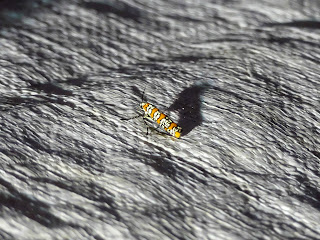Ailanthus Webworm Moth
Here's another moth I met at the Duke Farms mothing event: the Ailanthus Webworm Moth. Despite the nighttime event where this fella showed up, you can frequently see them in broad daylight too. In fact, that's when I usually see them.
There are (at least) 2 interesting things about these moths. First, they don't look much like moths. With their wings held close to their bodies, they could easily pass for some sort of beetle. You might think they look more like moths when they fly, but I'm told they look more like wasps when in flight.
The 2nd interesting thing about them is the Ailanthus Webworm Moth wasn't originally from around here; they were originally from southern Florida to Costa Rica where they would (as caterpillars) eat Paradise Trees (or a related tree that will remain nameless). Because this was where their food was, this is where these moths would hang out.
In 1784 though something happened that would eventually (though not immediately) allow them to greatly expand their range. That was the year that Ailanthus Trees (aka Trees of Heaven) were introduced to our region, specifically Philadelphia. This tree is in the same family as the host plants for the Ailanthus Webworm Moth.
As Ailanthus Trees exploded in numbers (becoming one of our earliest very invasive plants), their range spread south. Once they got to southern Florida, the Ailanthus Webworm Moth took notice and realized that these new-found trees were good for them to eat too. And unlike their other food sources, this food source could tolerate northern temperatures. The Ailanthus Webworm Moth began to colonize wherever there were Ailanthus Trees.
There is some question about the fate of the Ailanthus Webworm Moth, at least in our area. That's because there is another invasive species that threatens the Ailanthus Trees: the dreaded Spotted Lanternfly. The Spotted Lanternfly is a threat to many of our trees and shrubs, but they're especially fond of Ailanthus Trees. If the SLF kills off the Ailanthus Trees, it seems likely that the Ailanthus Webworm Moths will be without their primary food source. Perhaps they'll disappear from our area. Or perhaps there's something else up here that they'll be able to eat instead. (There are reports that they'll eat sumac too.)
So that's my tangled tale for the day. An out-of-range moth might be threatened by the loss of one invasive species of tree due to the appearance of an invasive species of bug.
 |
| August 20, 2021 at Duke Farms Photo 157559100, (c) jpviolette, some rights reserved (CC BY-NC) |



Comments
Post a Comment